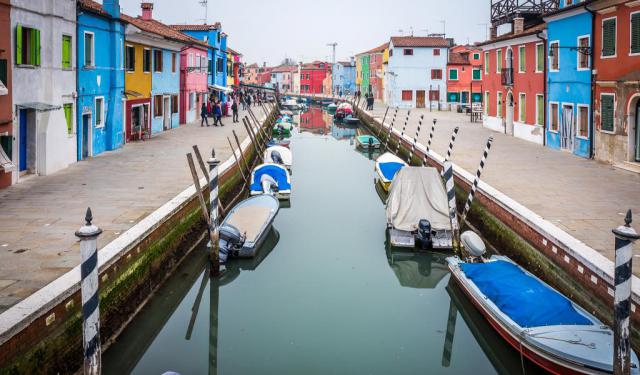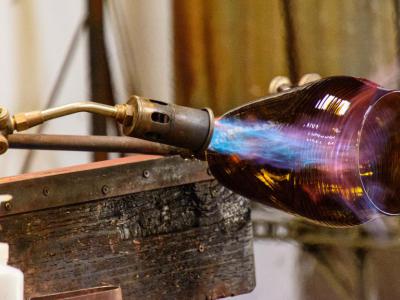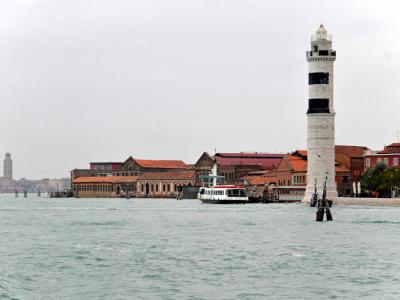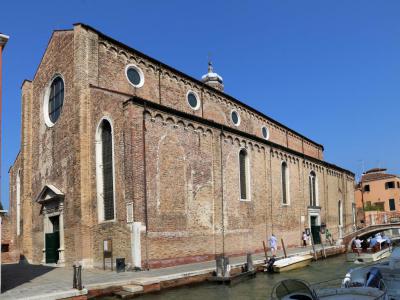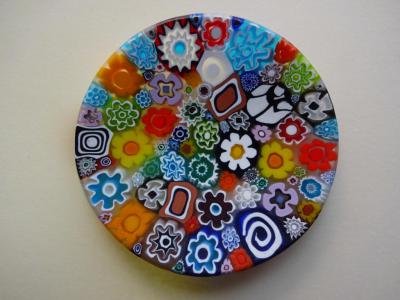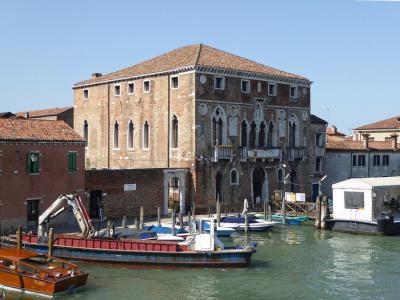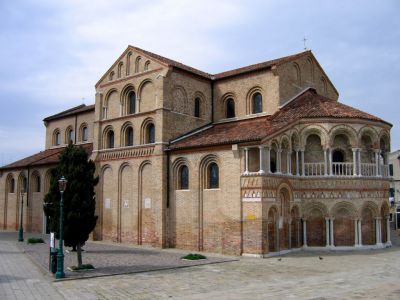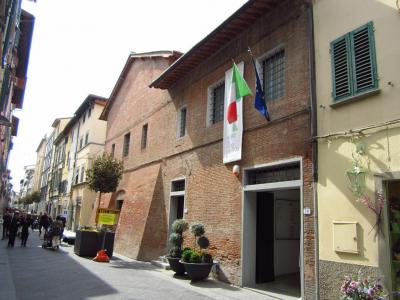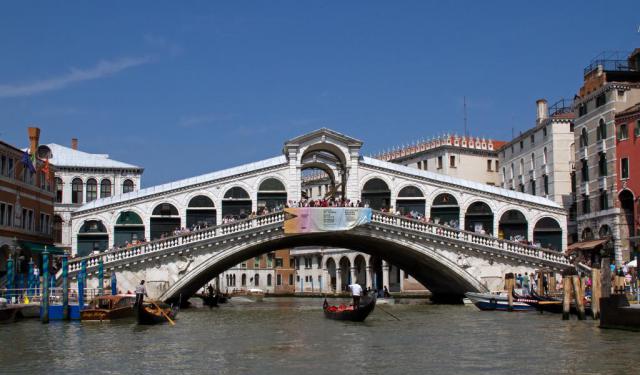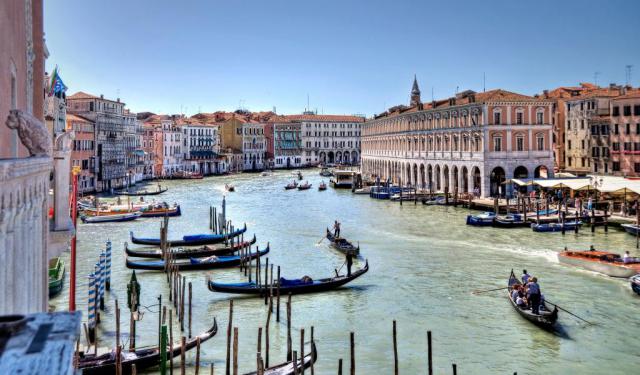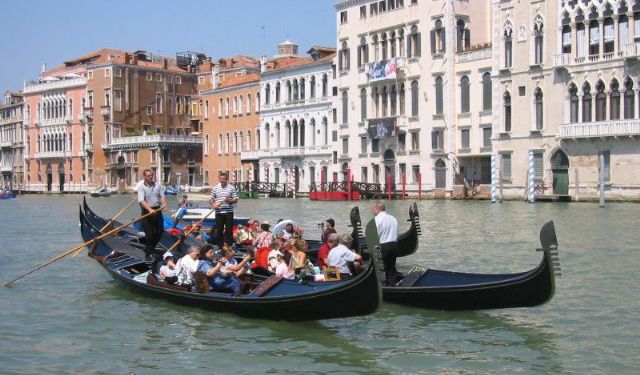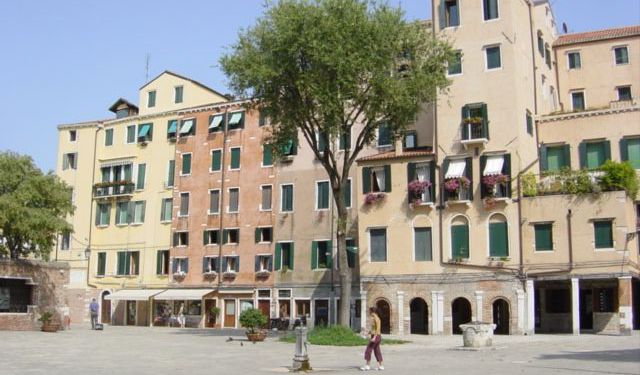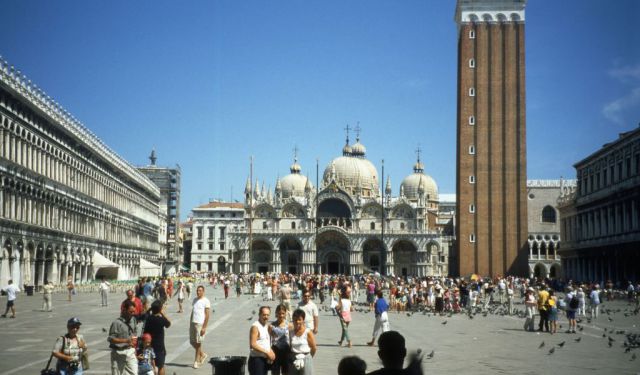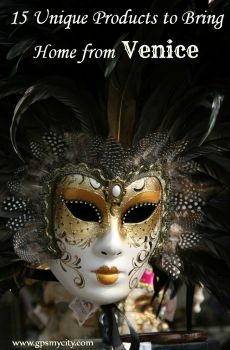Murano Island Walking Tour (Self Guided), Venice
Murano is often called the Glass Island, since it is home to the most impressive and renowned Venetian glass factories. The master craftsmen here have preserved their centuries-old techniques, and the island is full of shops where you can admire and purchase their adorable glass items. Some factories, such as Gino Mazzuccato’s, at the start of this self-guided walk, even have special showrooms where you can see the full process of glass-making firsthand.
One of the first visible sights as you approach Murano is the lighthouse (or “faro”), which is nothing too extravagant, but a good spot for photos or for sitting by the water and enjoying the boats crossing by. Follow with a stop by the San Pietro church to get your ‘fix’ of classical art (including some lovely chandeliers made from Murano glass), then stop by Fratelli Toso’s – one of the major contributors to modern glass design.
While it would probably go unnoticed on the Grand Canal, the tiny Palazzo da Mula is one of the island’s few elegant patrician buildings in a beautiful 12th-century Venetian Gothic style. Even more charming, equally from the outside as from the inside, is the Duomo de Murano across the bridge, whose main draw lies in the floor mosaics.
On the last stretch, do acquaint yourself with the Glass Museum’s unique collection of historic pieces that will help you understand how gloriously exquisite and sophisticated Venetian glass can be. Small and never crowded, it packs all the different varieties of glass techniques and decorations in less than an hour, and allows taking pictures.
For a great half a day out on beautiful Glass Island, follow this self-guided walking tour!
Getting to Sight #1. The first tour stop (Gino Mazzuccato) can be reached by: Alilaguna Water Taxi: Blue (B), Water Bus: 3, 4.1, 4.2, 7.
One of the first visible sights as you approach Murano is the lighthouse (or “faro”), which is nothing too extravagant, but a good spot for photos or for sitting by the water and enjoying the boats crossing by. Follow with a stop by the San Pietro church to get your ‘fix’ of classical art (including some lovely chandeliers made from Murano glass), then stop by Fratelli Toso’s – one of the major contributors to modern glass design.
While it would probably go unnoticed on the Grand Canal, the tiny Palazzo da Mula is one of the island’s few elegant patrician buildings in a beautiful 12th-century Venetian Gothic style. Even more charming, equally from the outside as from the inside, is the Duomo de Murano across the bridge, whose main draw lies in the floor mosaics.
On the last stretch, do acquaint yourself with the Glass Museum’s unique collection of historic pieces that will help you understand how gloriously exquisite and sophisticated Venetian glass can be. Small and never crowded, it packs all the different varieties of glass techniques and decorations in less than an hour, and allows taking pictures.
For a great half a day out on beautiful Glass Island, follow this self-guided walking tour!
Getting to Sight #1. The first tour stop (Gino Mazzuccato) can be reached by: Alilaguna Water Taxi: Blue (B), Water Bus: 3, 4.1, 4.2, 7.
How it works: Download the app "GPSmyCity: Walks in 1K+ Cities" from Apple App Store or Google Play Store to your mobile phone or tablet. The app turns your mobile device into a personal tour guide and its built-in GPS navigation functions guide you from one tour stop to next. The app works offline, so no data plan is needed when traveling abroad.
Murano Island Walking Tour Map
Guide Name: Murano Island Walking Tour
Guide Location: Italy » Venice (See other walking tours in Venice)
Guide Type: Self-guided Walking Tour (Sightseeing)
# of Attractions: 7
Tour Duration: 1 Hour(s)
Travel Distance: 2.3 Km or 1.4 Miles
Author: DanaOffice
Sight(s) Featured in This Guide:
Guide Location: Italy » Venice (See other walking tours in Venice)
Guide Type: Self-guided Walking Tour (Sightseeing)
# of Attractions: 7
Tour Duration: 1 Hour(s)
Travel Distance: 2.3 Km or 1.4 Miles
Author: DanaOffice
Sight(s) Featured in This Guide:
- Gino Mazzuccato
- Faro dell'Isola di Murano (Murano Lighthouse)
- Chiesa di San Pietro Martire (Church of St. Peter Martyr)
- Collezione Fratelli Toso
- Palazzo da Mula (da Mula Palace)
- Basilica dei Santi Maria e Donato (Basilica of Sts. Mary and Donatus)
- Museo del Vetro (Murano Glass Museum)
1) Gino Mazzuccato
Founded in 1958, Gino Mazzuccato stands as one of the prominent glass factories in Murano. With a rich history rooted in traditional craftsmanship, the company has embarked on a new venture, creating a contemporary collection of glass pieces that cater to the diverse tastes of its clientele.
For those eager to witness the artistry firsthand, the factory boasts several demonstration rooms where skilled craftsmen effortlessly shape, design, and infuse vibrant colors into the glass. Along the way, visitors are provided with insightful descriptions of the history and intricate process.
The accompanying shop presents an extensive range of glass products, ensuring there is something to suit every budget. From elegant chandeliers, exquisite mirrors and sculptures to decorative items and stylish drinking glasses, the selection is diverse and appealing. For those seeking a more luxurious experience, a dedicated higher-end room on the ground floor and upscale showrooms upstairs showcase exceptional items priced at $1000 and beyond.
For those eager to witness the artistry firsthand, the factory boasts several demonstration rooms where skilled craftsmen effortlessly shape, design, and infuse vibrant colors into the glass. Along the way, visitors are provided with insightful descriptions of the history and intricate process.
The accompanying shop presents an extensive range of glass products, ensuring there is something to suit every budget. From elegant chandeliers, exquisite mirrors and sculptures to decorative items and stylish drinking glasses, the selection is diverse and appealing. For those seeking a more luxurious experience, a dedicated higher-end room on the ground floor and upscale showrooms upstairs showcase exceptional items priced at $1000 and beyond.
2) Faro dell'Isola di Murano (Murano Lighthouse)
Located in the southeastern part of Murano Island, the Murano Lighthouse proudly stands as an active beacon. As you approach Murano by boat, it greets you with its illuminating presence, providing guidance and serving as a picturesque sight. Although it cannot be climbed, it offers a wonderful opportunity for capturing memorable photos.
The original lighthouse, built in 1912, featured a metal skeletal tower mounted on piles; however, it was decommissioned in 1934 upon completion of the current operational lighthouse. This structure showcases a two-stage cylindrical stone tower, towering at a height of 35 meters, or 115 feet. Adorned with a double balcony and a lantern, it is painted white, while the upper stage boasts two distinct black horizontal bands facing the range line on the east side. This clever design element ensures enhanced visibility during daylight hours.
The original lighthouse, built in 1912, featured a metal skeletal tower mounted on piles; however, it was decommissioned in 1934 upon completion of the current operational lighthouse. This structure showcases a two-stage cylindrical stone tower, towering at a height of 35 meters, or 115 feet. Adorned with a double balcony and a lantern, it is painted white, while the upper stage boasts two distinct black horizontal bands facing the range line on the east side. This clever design element ensures enhanced visibility during daylight hours.
3) Chiesa di San Pietro Martire (Church of St. Peter Martyr)
Situated on Fondamenta dei Vetrai, a street deeply rooted in the glass industry (as its name implies), now primarily known as a tourist hotspot, the Dominican church of Saint Peter Martyr ("San Pietro Martire") is one of the two remaining active churches on the island, a significant decrease from the seventeen that stood when the Republic fell in 1797.
Originally constructed in 1363, the church underwent extensive rebuilding following a devastating fire in 1474. Within its walls, a few remarkable paintings grace the interior, most notably Giovanni Bellini's grand and graceful "Madonna and Child" with Saint Mark, Saint Augustine, and Doge Barbarigo. Another altarpiece by Bellini and his workshop, depicting the Assumption, is said to hang nearby; although it has been under restoration for years, it may soon be unveiled. On the opposite side of the church, two works by Veronese, "Saint Agatha in Prison" and "Saint Jerome in the Desert", can be admired.
To the left of the main altar, the Chapel of the Sacrament ("Cappella del Sacramento"), originally dedicated to the angels, showcases four paintings portraying amiable angelic figures. The sacristy, accompanied by a modest museum, is particularly notable for its wood-carvings in the vestry. These carvings feature extraordinary Baroque atlantes representing historical and mythological characters such as Nero, Socrates, Pythagoras, and Pontius Pilate, complemented by the Four Seasons flanking the altar.
Originally constructed in 1363, the church underwent extensive rebuilding following a devastating fire in 1474. Within its walls, a few remarkable paintings grace the interior, most notably Giovanni Bellini's grand and graceful "Madonna and Child" with Saint Mark, Saint Augustine, and Doge Barbarigo. Another altarpiece by Bellini and his workshop, depicting the Assumption, is said to hang nearby; although it has been under restoration for years, it may soon be unveiled. On the opposite side of the church, two works by Veronese, "Saint Agatha in Prison" and "Saint Jerome in the Desert", can be admired.
To the left of the main altar, the Chapel of the Sacrament ("Cappella del Sacramento"), originally dedicated to the angels, showcases four paintings portraying amiable angelic figures. The sacristy, accompanied by a modest museum, is particularly notable for its wood-carvings in the vestry. These carvings feature extraordinary Baroque atlantes representing historical and mythological characters such as Nero, Socrates, Pythagoras, and Pontius Pilate, complemented by the Four Seasons flanking the altar.
4) Collezione Fratelli Toso
Founded in 1854 by six brothers with a deep passion for the art of glassmaking, Fratelli Toso is one of the oldest and most esteemed glass factories in Murano. With a rich history spanning over 150 years, the Toso family has continuously refined their techniques, establishing themselves as renowned manufacturers of Murano glass and earning numerous accolades. Their diverse range of creations encompasses everything from exquisite chandeliers to delightful glass souvenirs.
Among Fratelli Toso's notable contributions to Murano's glassmaking heritage is their exquisite "murrine", also known as "millefiori". This ancient technique involves the fusion of colorful glass canes, resulting in intricate patterns and shapes within the glass. Once the fused canes have cooled, they are meticulously sliced into small pieces, yielding delicate circular beads called "murrine." During the 19th century, the Toso family became so renowned for their millefiori craftsmanship that they were referred to as "murrinari." Today, their extensive collection of millefiori pieces continues to captivate with its beauty and artistry.
Among Fratelli Toso's notable contributions to Murano's glassmaking heritage is their exquisite "murrine", also known as "millefiori". This ancient technique involves the fusion of colorful glass canes, resulting in intricate patterns and shapes within the glass. Once the fused canes have cooled, they are meticulously sliced into small pieces, yielding delicate circular beads called "murrine." During the 19th century, the Toso family became so renowned for their millefiori craftsmanship that they were referred to as "murrinari." Today, their extensive collection of millefiori pieces continues to captivate with its beauty and artistry.
5) Palazzo da Mula (da Mula Palace)
On the Grand Canal of Murano, just a few steps away from the Vivarini Bridge, the da Mula Palace stands as a splendid example of Venetian Gothic architecture. Although it dates back to the 12th or 13th century, the palace has undergone extensive remodeling over the years. Nevertheless, the magnificent façade remains almost unaltered, adorned with remnants of Venetian-Byzantine decoration of considerable artistic interest, in which ornaments such as "patera" (dish-like designs) and tiles remain embedded.
Originally intended as a summer residence for the da Mula family, who, like many Venetian nobles, would retreat from the city during the warmer months, the palace has experienced numerous structural changes due to the presence of a glass factory. Unfortunately, these modifications have erased much of its historical significance, leaving behind a stripped interior. Presently, the palace serves as a venue for temporary art exhibitions and houses a municipal registry office and other services on alternating days.
Originally intended as a summer residence for the da Mula family, who, like many Venetian nobles, would retreat from the city during the warmer months, the palace has experienced numerous structural changes due to the presence of a glass factory. Unfortunately, these modifications have erased much of its historical significance, leaving behind a stripped interior. Presently, the palace serves as a venue for temporary art exhibitions and houses a municipal registry office and other services on alternating days.
6) Basilica dei Santi Maria e Donato (Basilica of Sts. Mary and Donatus)
Famous for its 12th-century Byzantine mosaic floor, this basilica is believed to house the relics of Saint Donatus of Arezzo, as well as a number of large bones behind the altar said to belong to a dragon slain by the saint.
The church itself is one of the oldest in the Venetian lagoon, originally constructed in the 7th century and known to have undergone reconstruction in the 9th century and in 1040 AD (although subsequent renovations may have taken place due to Venice's common issues with water damage and other challenges).
Taking just a few minutes to appreciate both its interior and exterior, it is certainly worth a visit, especially for its impressive colonnaded facade on the eastern side facing a canal. Inside, you'll find a remarkable glass mosaic along with floor mosaics made from precious stones such as porphyry and serpentine, which are among the most impressive of their kind in Venice and possibly beyond.
The church itself is one of the oldest in the Venetian lagoon, originally constructed in the 7th century and known to have undergone reconstruction in the 9th century and in 1040 AD (although subsequent renovations may have taken place due to Venice's common issues with water damage and other challenges).
Taking just a few minutes to appreciate both its interior and exterior, it is certainly worth a visit, especially for its impressive colonnaded facade on the eastern side facing a canal. Inside, you'll find a remarkable glass mosaic along with floor mosaics made from precious stones such as porphyry and serpentine, which are among the most impressive of their kind in Venice and possibly beyond.
7) Museo del Vetro (Murano Glass Museum) (must see)
Museo del Vetro is an excellent destination for discovering the rich history of glassmaking, including the renowned Murano glass, and observing authentic examples, some dating back 500 years! With a total of eight rooms featuring different themes, visitors can easily spend an hour immersing themselves in the informative displays and admiring the exquisite pieces.
The collection includes astonishing ancient Syrian glassworks that must be seen to be truly appreciated, as well as striking contemporary creations. For an even more immersive experience, visitors have the opportunity to purchase a combined ticket that includes a demonstration by skilled glass artisans, allowing them to witness the craft in action.
The palace housing the museum was built in typical Flamboyant Gothic style. In 1659, it became the residence of Bishop Marco Giustinian, who later acquired the property and donated it to the Torcello diocese. In 1861, it transformed into the town hall of Murano Municipality, utilizing the first floor to showcase glass artworks by local artists. Over time, the collection expanded, gradually encompassing the entire building. Notably, the magnificent chandeliers suspended from the ceiling are among the museum's standout features.
Tip:
Don't forget to visit the gift shop, offering great value and a chance to acquire unique items while avoiding the touristy kitsch often found in commercial establishments.
The collection includes astonishing ancient Syrian glassworks that must be seen to be truly appreciated, as well as striking contemporary creations. For an even more immersive experience, visitors have the opportunity to purchase a combined ticket that includes a demonstration by skilled glass artisans, allowing them to witness the craft in action.
The palace housing the museum was built in typical Flamboyant Gothic style. In 1659, it became the residence of Bishop Marco Giustinian, who later acquired the property and donated it to the Torcello diocese. In 1861, it transformed into the town hall of Murano Municipality, utilizing the first floor to showcase glass artworks by local artists. Over time, the collection expanded, gradually encompassing the entire building. Notably, the magnificent chandeliers suspended from the ceiling are among the museum's standout features.
Tip:
Don't forget to visit the gift shop, offering great value and a chance to acquire unique items while avoiding the touristy kitsch often found in commercial establishments.
Walking Tours in Venice, Italy
Create Your Own Walk in Venice
Creating your own self-guided walk in Venice is easy and fun. Choose the city attractions that you want to see and a walk route map will be created just for you. You can even set your hotel as the start point of the walk.
Around Rialto Bridge
Having first appeared in documents that date back to the 9th century, the Rialto district was almost completely destroyed by fire in 1514, with the church of San Giacomo as the only structure left standing. Today, it is a busy urban village with a daily vegetable and fish market, several historic sights, plus a wide variety of shopping and dining options. Our self-guided walking tour takes you to... view more
Tour Duration: 1 Hour(s)
Travel Distance: 0.4 Km or 0.2 Miles
Tour Duration: 1 Hour(s)
Travel Distance: 0.4 Km or 0.2 Miles
Venice Introduction Walking Tour
Although most experts agree that the Venetian lagoon emerged nearly 6,000 years ago, the area of today's Venice remained mostly uninhabited, except for a small population of fishermen, up until the 5th century AD when the hordes of Gothic barbarians, looting their way into Rome, drove many a people away from their homes on the mainland to take refuge on the coastal Venetian islands.
Those... view more
Tour Duration: 3 Hour(s)
Travel Distance: 4.1 Km or 2.5 Miles
Those... view more
Tour Duration: 3 Hour(s)
Travel Distance: 4.1 Km or 2.5 Miles
Grand Canal Walking Tour
The main waterway in Venice, Grand Canal snakes in an "S" shape through the center of the city, dividing its main districts. On both sides of this thoroughfare are the most beautiful buildings dating from the 12th to the 18th centuries that tell the story of a thousand years of Venetian splendor. While one can view the architectural parade from water buses, our self-guided walking tour... view more
Tour Duration: 3 Hour(s)
Travel Distance: 5.2 Km or 3.2 Miles
Tour Duration: 3 Hour(s)
Travel Distance: 5.2 Km or 3.2 Miles
Jewish Ghetto Tour
Founded in 1516, the Jewish Ghetto in Venice was the oldest of its kind in all Europe. At the time, Venice received order from the Pope to expel all Jews from the city, but the Venetian government opted to lock them onto a small island in the district of Cannaregio. Since then this small area has been the center of Jewish life in Venice, with buildings rising vertically to accommodate the rising... view more
Tour Duration: 1 Hour(s)
Travel Distance: 0.4 Km or 0.2 Miles
Tour Duration: 1 Hour(s)
Travel Distance: 0.4 Km or 0.2 Miles
Titian's Paintings Walk
One of the greatest painters of all time, Tiziano Vecelli – better known as Titian – was a pioneering figure of the Venetian school of Italian Renaissance painting. His career was successful from the start, and he became sought after by patrons, initially from Venice and its possessions, then joined by the north Italian princes, and finally the Habsburgs and papacy.
Equally adept with... view more
Tour Duration: 2 Hour(s)
Travel Distance: 3.6 Km or 2.2 Miles
Equally adept with... view more
Tour Duration: 2 Hour(s)
Travel Distance: 3.6 Km or 2.2 Miles
Piazza San Marco Walking Tour
All of Venice’s roads seem to run into Piazza San Marco – the commercial, religious, and political heart of the city. With a glowing reputation as one of the finest squares in the world and arguably one of Europe’s primary tourist attractions, it certainly has a lot to offer to visitors.
Start your exploration with a tour of the pink-and-white marble Palazzo Ducale, which takes you... view more
Tour Duration: 1 Hour(s)
Travel Distance: 0.6 Km or 0.4 Miles
Start your exploration with a tour of the pink-and-white marble Palazzo Ducale, which takes you... view more
Tour Duration: 1 Hour(s)
Travel Distance: 0.6 Km or 0.4 Miles
Useful Travel Guides for Planning Your Trip
15 Distinctively Italian Things to Buy in Venice
Venice has been a tourist mecca for over a century now, with millions of visitors flocking in every year to see this unique place on the face of the Earth. Many, if not all, of these people seek to obtain something memorable as a token of their stay in this city. By far, not all of them know which...
The Most Popular Cities
/ view all
